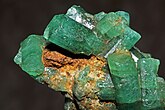Muzo
Muzo
Villa de la Santísima Trinidad de los Muzos | |
|---|---|
Municipality and town | |
 View of Muzo | |
|
UTC-5 (Colombia Standard Time) | |
| Website | Official website |
Muzo (Spanish pronunciation: [ˈmuso]) is a town and municipality in the Western Boyacá Province, part of the department of Boyacá, Colombia. It is widely known as the world capital of emeralds for the mines containing the world's highest quality gems of this type. Muzo is situated at a distance of 178 kilometres (111 mi) from the departmental capital Tunja and 118 kilometres (73 mi) from the capital of the Western Boyacá Province, Chiquinquirá. The urban centre is at an altitude of 815 metres (2,674 ft) above sea level. Muzo borders Otanche and San Pablo de Borbur in the north, Maripí and Coper in the east, Quípama in the west and the department of Cundinamarca in the south.[1]
Etymology
The town of Muzo was called Villa de la Santísima Trinidad de los Muzos, or simply Trinidad, when the
Climate
The median temperature of Muzo is 26 °C (79 °F) and the annual precipitation 3,152 millimetres (124.1 in).[1]
History
Before the
The Cariban-speaking Muzo, like their Chibcha neighbours, adored the Sun and Moon as deities. Unlike their eastern neighbours, they did not construct temples.[3]
Spanish conquest
After the successful conquest by the Spanish of the eastern neighbours, the
A third campaign to submit the Muzo was executed by conquistador Pedro de Ursúa in 1552. Also he failed to conquer the Muzo. A fourth time the Spanish attempted to subdue the Muzo to the Spanish Crown was successful; Luis Lanchero returned to the area where he was driven out almost two decades earlier, defeated the Muzo and founded the town of Villa de la Santísima Trinidad de los Muzos on February 20, 1559.[1]
Colonial period
The first evangelisation was performed by
Economy
The main economical activity with approximately 75% of the municipal income is emerald mining. Agriculture and livestock farming comprise the remaining quarter of the economy of Muzo. Agricultural products cultivated are
Emerald mining
The Muzo mines are situated in the western flank of the
The US National Museum Division of Mineralogy and Petrology carried out a study of the mines in 1916.
Gallery
-
Emerald from Muzo
-
Muzo emeralds
-
Emerald
-
Individual emerald
See also
References
Bibliography
- Branquet, Yannick; Laumonier, Bernard; Cheilletz, Alain; Giuliani, Gaston (1999). "Emeralds in the Eastern Cordillera of Colombia: Two tectonic settings for one mineralization" (PDF). Geology. 27: 597–600. Retrieved 2017-01-05.
- Giuliani, Gaston; Cheilletz, Alain; Arboleda, Carlos; Carrillo, Victor; Rueda, Félix; Baker, James H. (1995). "An evaporitic origin of the parent brines of Colombian emeralds: fluid inclusion and sulphur isotope evidence" (PDF). European Journal of Mineralogy. 7: 151–165. Retrieved 2017-01-05.
- Henao, Jesús María; Arrubla, Gerardo (1820). Historia de Colombia para la enseñanza secundaria [History of Colombia for the secondary education] (in Spanish). Indiana University. pp. 1–592. Retrieved 2016-07-08.
- Ortega Medina, Laura Milena (2007). Tipología y condiciones de formación de las manifestaciones del sector esmeraldífero "Peña Coscuez" (municipio San Pablo de Borbur, Boyacá) (PDF) (MSc. thesis). Universidad Industrial de Santander. pp. 1–121. Retrieved 2017-01-05.
- ISBN 978-958-14-1416-1.
- Pignatelli, Isabella; Giuliani, Gaston; Ohnenstetter, Daniel; Agrosì, Giovanna; Mathieu, Sandrine; Morlot, Christophe; Branquet, Yannick (2015). "Colombian Trapiche Emeralds: Recent Advances in Understanding Their Formation". Gems & Gemology. LI: 222–259.
- Puche Riart, Octavio (1996). La explotación de las esmeraldas de Muzo (Nueva Granada), en sus primeros tiempos [The exploitation of the emeralds of Muzo (New Kingdom of Granada), the first period] (PDF) (in Spanish). Vol. 3. pp. 99–104. ISBN 0902806-38-6. Retrieved 2016-07-08.
- Tequia Porras, Humberto (2008). Asentamiento español y conflictos encomenderos en Muzo desde 1560 a 1617 - Spanish settlement and encomienda conflicts in Muzo from 1560 to 1617 (M.A.) (PDF) (M.A. thesis) (in Spanish). Pontificia Universidad Javeriana. pp. 1–91. Retrieved 2016-07-08.
- Uribe, Sylvano E. (1960). "Las esmeraldas de Colombia" [The emeralds from Colombia] (PDF). Boletín de la Sociedad Geográfica de Colombia. 65 (in Spanish). XVIII: 1–8. Retrieved 2016-07-08.
External links
- MUZO Emerald Colombia official site of Muzo Emeralds, with details on the emerald mine
- The Emerald Deposits of Muzo, Colombia Online copy of the 1916 U.S. National Museum study





